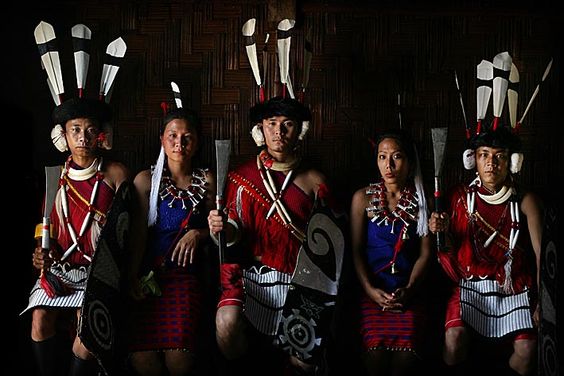The Aos are a Naga ethnic group in the state of Nagaland. The Word ‘Aor’ or ‘Ao’ means ‘going’ or ‘gone’ which refers to a group of the population who migrated from Chungliyimti crossing the Dikhu River. Chungliyimti was where the social life progressed and manifested itself in embarking on a new beginning of civilization for the Ao-Nagas. However, with the surge in population, the Aos started migrating to different places, where they made their settlements and formed individual villages. As a result of which, the Aos now consists of almost 227,000 populations (2011 census).
The land of the Aos is basically located in the North-East part of Nagaland. To their east reside the Phoms, Changs and Sangtams, in the south are the Lothas and Semas. Assam in the west and Konyaks in the north. Mokokchung is the district headquarters of the Ao people and its latitude is 1325.8 metres above sea level. The Ao land is now divided into six ranges, namely Ongpangkong, Langpangkong, Asetkong, Japukong, Tzurangkong and Jangpetkong. ‘Dikhu’ and ‘Disai’ forms the important rivers for the Aos.

With regard to the origin of the Ao-Nagas, tradition has it that the Aos came out of the stone called ‘Longterok’, which means ‘six stones’ which is presently situated in Chungliyangti village under Tuensang district. The Aos like every other Naga people has its own dialect, which is composed of three different languages representing Mongsen, Chungli and Changki. Out of which, Mongsen and Chungli are the two major dialects; Mongsen being poetic and original as all traditional songs, poetry, technical words and literary works are found in Mongsen while Chungli became the common official language.
The Aos lives in a well-defined and highly egalitarian society. In the Ao language, the notion of society is enshrined in the word ‘Loktiliba’. When roughly translated, it means ‘ways of life of the people.’ The Aos are very distinct in terms of village administration, distribution of clans, institutions and socio-cultural practices. The Ao system of village governance is identified as ‘Tatar Putu Menden’. Tatar means chosen leader, Putu means generation and Menden is the seat. ‘Putu Menden’ is the highest authority in any Ao Village. This is the highest of people having supreme power in the village administration and the representatives of various clans form this government. They are the rulers, administrators and the highest judges possessing the highest executive authority in the affairs of the village administration.
In social life, the Aos follow the patriarchal system, where the principle of exogamy is strictly implemented to date. Earlier, the concept of Morung formed the fundamental basis of the Ao cultural society. For boys, it was known as “Ariju” and for the girls, it was called “ Tsuki”, where they were taught and trained about manhood and womanhood respectively. However, in the present context, both terms have become more or less a part of the cultural heritage.
Agriculture has been the main source of economic activity and livelihood. The Aos believe in working hard and depends mostly on Jhum cultivation and animal husbandry. The significance of toiling the earth is being manifested in celebrating the two most important festivals related to cultivation viz Moatsu (the festival of post sowing) and Tsungremong( the festival of pre harvesting) which is celebrated in the month of May and August respectively.
The Aos before embracing Christianity believed in a natural phenomenon where they worshipped many gods, among which “ Lijaba”(God of Creation) was considered as the supreme God. Apart from worshipping different diety, the Aos was also actively engaged in headhunting and sacrifices. However, the advent of Christianity and western education totally transformed the animistic philosophy and brought changes in the social and cultural aspects among the life of the Aos.
————
Contributed to the International Council of Naga Affairs (ICNA) by Alila Ao (Assistant Professor, Department of History) & Nokchachila (Assistant Professor, Department of Sociology), C-Edge College, Dimapur, Nagaland. ICNA reserves all rights.
Featured Image: HumanPlanet/Timothy Allen
Content Image: Ao Naga lady in traditional attire/Pinterest; Ao Naga Gate/GoI-MinistryofCulture; Traditional Ao Naga men’s attire/Postink. The picture has been reworked/merged by the International Council of Naga Affairs (ICNA).
———-
REFERENCES
1. Ao, Temsula (2012). The Ao- Naga Oral Tradition. Dimapur: Heritage Publishing House.
2. Jamir, L. Sosang (2012). Ao Naga Customary Laws and Practices. Dimapur: Heritage Publishing House.
3. Jamir, N. Talitemjen & A. Lanunungsang. (2005). Naga Society and Culture. Lumani: Nagaland University Tribal Research Centre.
Web References
Trivedi, Anurag (2021). India’s Tribal Communities- The Ao Naga Tribe of Nagaland. Retrieved from https://www.shaan.academy/blog/indias-tribal-communities-the-ao-naga-tribe-of-nagaland-part-1; https://www.shaan.academy/blog/indias-tribal-communities-the-ao-naga-tribe-of-nagaland-part-2
———-
NOTICE: There are approximately 66/67 ethnic Naga groups. We only listed the Naga people’s nationality (ethnic Naga group) who had sent us a brief introduction. We welcome brief information (less than 1000 words) about each Naga people’s nationality/ethnic group. Please send the write-up submission to submissions@nagaaffairs.org with the subject line “For Naga People Listing.” It will be listed in the Naga “People” – Click Here

